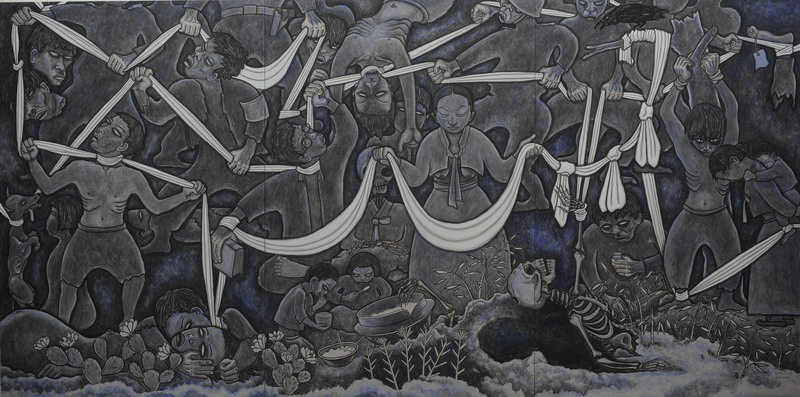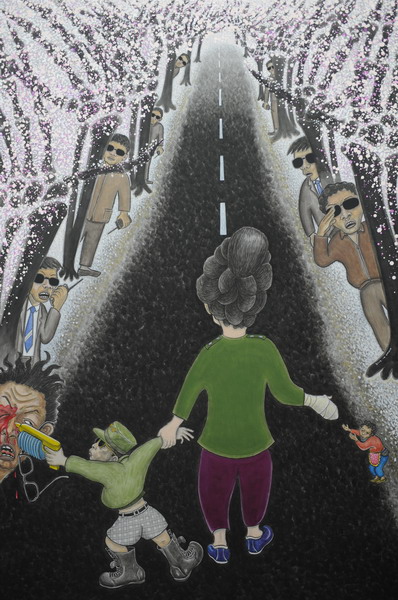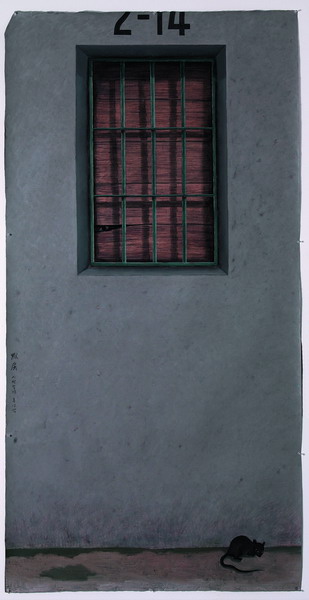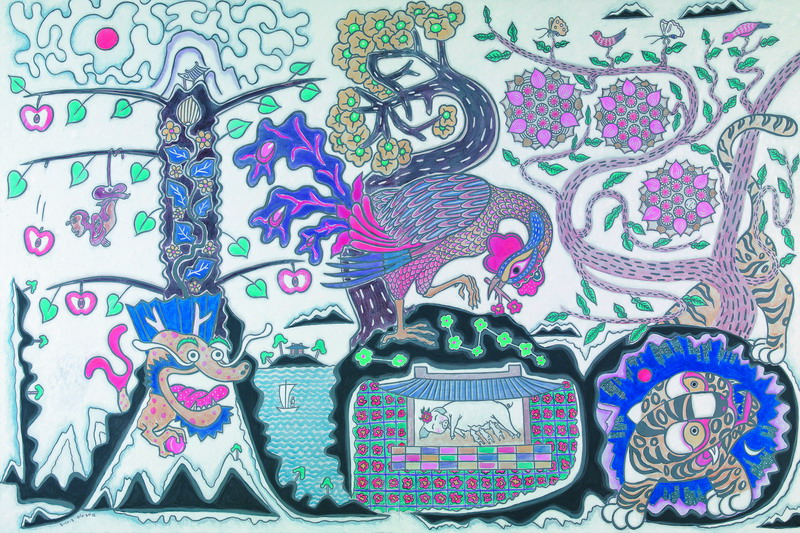Hong Sung-dam: Born into a History of Struggle
By Kang Jennis Hyun-suk.
I took an express train bound for Mokpo to meet the artist for the June issue of the Gwangju News. The magazine was eager to have an interview with the artist Hong Sung-dam (홍성담) because he is one of the artists who depicts the spirit of May 18, the spirit of democracy.
These days, Hong Sung-dam is working on opening an art museum on an island in Sinan County, where Hong was born and raised. As there were no middle schools on the islands, Hong went to Mokpo, the nearest city on the mainland, for his secondary school education. Sinan County consists of 1,004 islands in Jeollanam-do, off the western coast of the peninsula. Interestingly, the pronunciation of “1,004” is the same as that of “angel” in Korean, “cheonsa” (천사). Some of the islands in Sinan have now been connected to the mainland by bridges. The islands of Sinan County maintain a store of interesting history. I think that if you are aware of the artist’s background, it will help to understand the artist’s works more deeply.
Hometown History
Have you seen the movie The Book of Fish (Jasan-eobo, 자산어보)? The film, which is gaining in popularity these days, is set on one of the Sinan County islands. The story is about a scholar, Jeong Yakjeon (정약전, 1758–1816) who was exiled from the capital for political and religious reasons to the far western Shinan island of Heuksan-do (흑산도). He observed the fish of the area to make an encyclopedia of marine life and wrote additional books such as Pyohae-simal (표해시말, Adrift at Sea: An Account), the account of a sailor who was swept away by a typhoon while sailing from Japan to China via Macao and the Philippines. This record lets us know of the cultures of these far-eastern regions of the time and makes a comparison of their ship-building skills. Jeong Yakjeon was the elder brother of Dasan, Jeong Yakyong (1762–1836), who was also a famous scholar in the Joseon Dynasty. He was also exiled to Gangjin and remained there for 18 years for the same reasons as his older brother. Since these two scholars came to Jeolla Province, they have left their imprint in the form of many great books. Another famous person from Sinan County is the Nobel Peace Prize laureate, former president Kim Daejung (김대중). He was born on the island of Haui-do (하의도). Long ago, there were three islands in Ha-eui Township in Sinan County. The three islands have a history of various farmers’ uprisings for over 300 years. After the Japanese Invasions of Korea (1592–1598), the Joseon Dynasty realized the importance of keeping its islands and therefore encouraged its people to move to the islands. If someone reclaimed and cultivated barren land on the islands, the government would transfer the ownership to the farmer. But the king broke his word. In 1623, the three islands of Ha-eui were given to the princess Jong-myeong as a wedding present and the farmers on the land were taxed. This led to the beginning of the Farmers’ Uprisings of Haui-do. The descendants of the islanders fought for their rights, generation after generation, for over 300 years. Finally, the first National Assembly of Korea returned the land to the descendants of the farmers. At last, it all ended with a victory for the farmers.
The Memorial Hall of the Farmers’ Uprisings was built in 2009 on the island to honor the spirit of the resisters. At the inauguration of the Memorial Hall, Kim Dae-jung said in his speech, “I’ve come back from the edge of death five times, I was imprisoned six and a half years, I’d lived under surveillance for more than 20 years, and I lived in exile for three and a half years. But I fought with the indomitable spirit of the Farmers’ Uprisings of Haui-do.”
So with this in mind, what kind of artwork and impact has Hong Sung-dam made?

Hong, the Activist
On April 16, 2014, the ferry Sewol tragically sank with 304 causalities, mainly students who were on a school trip to Jeju Island. President Park Geun-hye was absent on that day, and the citizens were outraged by the government’s slow response and incompetence. At the 20th anniversary of the Gwangju Biennale in September of that year, Hong Sung-dam satirized Park Geun-hye as a scarecrow. Resultantly, Hong’s exhibition was canceled by the government and his name was put on the list of blacklisted artists.
In July 1989, the 13th World Festival of Youth and Students was held in Pyeongyang, North Korea. Lim Soo-kyung, a university student of South Korea, joined as a representative of the South Korean University Association of Student Unions. It surprised both Koreas and the world. In Seoul, 80 artists of the Student Art Movement Association, which included Hong Sung-dam, portrayed the history of Korea’s National Liberation Movement on a huge hanging painting. The painting was 77 meters wide, depicting the Donghak Peasant Uprising, the Korean War, and the May 18 Gwangju Uprising. The painting itself was destroyed by the police, but a video of the painting had been made. The video was sent to Pyeongyang via a third country, and the young artists in Pyeongyang recreated the painting to display at the World Festival of Youth and Students. Hong was arrested for his interaction with North Korean artists, tortured, and jailed for three years. It was on this topic that our interview began.

The Interview
Jennis: What was your life like after getting out of prison? Why do you still paint satire?
Hong Sung-dam: Amnesty International helped save my life. After my release from prison, I was invited to many countries to give talks. In order to repay Amnesty International for its kind help, I thought that I should report various forms of state violence across borders with artists in East Asian countries who were opening their eyes to civil rights.
Jennis: I heard you exhibited at the Insa Art Center in Seoul in 2018. What kind of artwork did you exhibit there?
Hong Sung-dam: They were paintings depicting various states of violence and citizens’ movements. I painted candlelight vigils, the Japanese military sexual slavery case, the Sewol Ferry case, and violence by the military government. My paintings were exhibited at one of the biggest commercial galleries in Korea. I think it means that the scope of people’s art and realism has expanded.
Jennis: Would you tell me about the Museum of Human Rights and Peace for East Asia in Sinan County that you are working on these days?
Hong Sung-dam: We are working towards the goal of opening the museum in 2023. We are planning to open a residency program so that East Asian artists can paint for human rights and peace at ease. And we are also planning to open a Human Rights and Peace Camp so that parents and children might participate during their vacation. Above all, the local residents should be the owners of the museum. So, our team is recording the movements on human rights and peace in Sinan County, including the Amtae-do tenant dispute and the Farmers’ Uprisings of Haui-do.

Jennis: What are your plans for your next art projects?
Hong Sung-dam: Sometimes I take a walk along the beach. After heavy winds, I spot trash that has washed up on the beach. The snack bags and PET bottles are from India, Australia, China, and many other countries. Since last October, I have been working on a coastal environment art movement with several artists who have agreed to be part of the project. Our environmental art exhibition, which started in Jaeun-do, in Sinan, will travel around Incheon, Samcheok, Ulsan, Busan, and Yeosu, and then will be held as an archive exhibition in Mokpo in about a year.
Jennis: What is your personal definition of “art”?
Hong Sung-dam: Art should create controversy. Common sense is not art. Art must always go beyond social taboos. As a nation moves towards dictatorship, there will inevitably be more satire. Art must be at odds with power.
Jennis: And what kind of person is an artist?
Hong Sung-dam: A person with imagination, who evokes the seriousness of events with humor and satire. I think it is the role of the artist to act as a fermentation enzyme to depict for the public the breathtaking impact events have on society.

Meok-bang, homonym for “eating-broadcast” and eating room (= prison), by Hong Sung-dam (1998).
After the Interview
During the May 18 Uprising, Hong Sung-dam participated in the “citizens’ army.” He witnessed the deaths of innocent lives and afterwards devoted his passion to telling the truth about the Gwangju Uprising. Hong was selected as one of the world’s top three prisoners of conscience by Amnesty International in 1990. And he was selected by the American news publication Foreign Policy as one of the “Leading Global Thinkers of 2014: A Disrupted World.” Hong is working with other artists and activists in East Asia and making efforts across borders to restore human rights, advance de-nuclearization, and protect the global environment.
“Art should create controversy. Common sense is not art. Art must always go beyond social taboos.”
After our interview, Hong gave me something that he wrote for a friend. It was the preface of a book by Yamaguchi Izumi, a Japanese writer, artist, and de-nuclearization activist. I will close with that preface:
The people of the world have suffered from the Pacific War instigated by Japan. The trauma is still ongoing, but Japan has never sincerely apologized, even though the people of Asia have sent condolences and encouragement to the Japanese people who have suffered from the disastrous earthquake in Fukushima in 2011. We believed that Japan would change after the Great Earthquake. However, Japan has announced that it will hold the Fukushima Revival Olympics and release Fukushima radioactive water into the Pacific Ocean unilaterally. I still cannot forget the despair in my friend’s eyes when he noted the accident at the Fukushima nuclear power plant. But I hold a ray of hope because there are activists like Yamaguchi in Japan.
Photographs courtesy of Hong Sung-dam.
The Author
Kang Jennis Hyunsuk is a freelance interpreter who loves to read books, take photos of nature, and walk her dog. She has lived in Gwangju all her life and is surely a lover of the City of Light.





